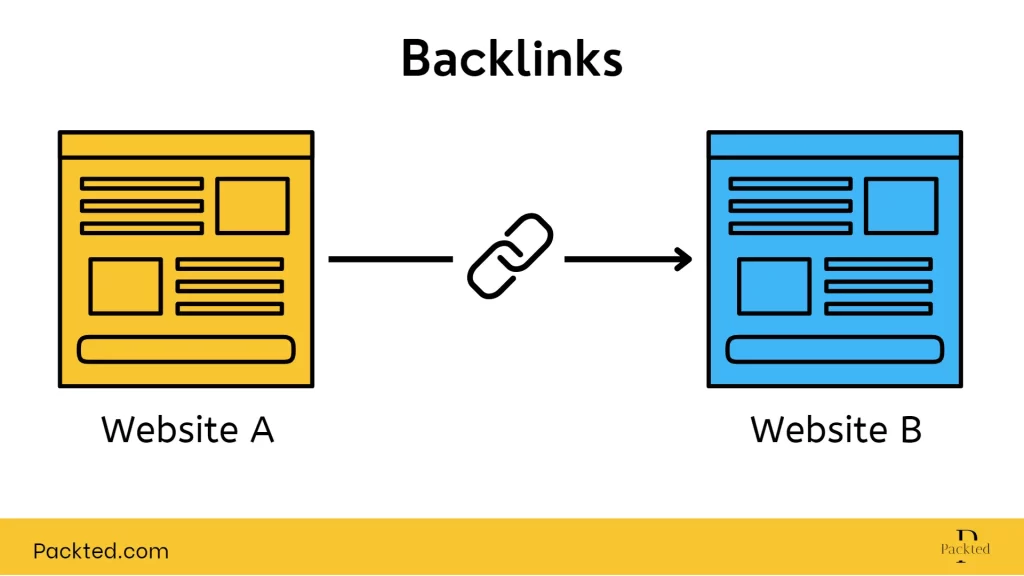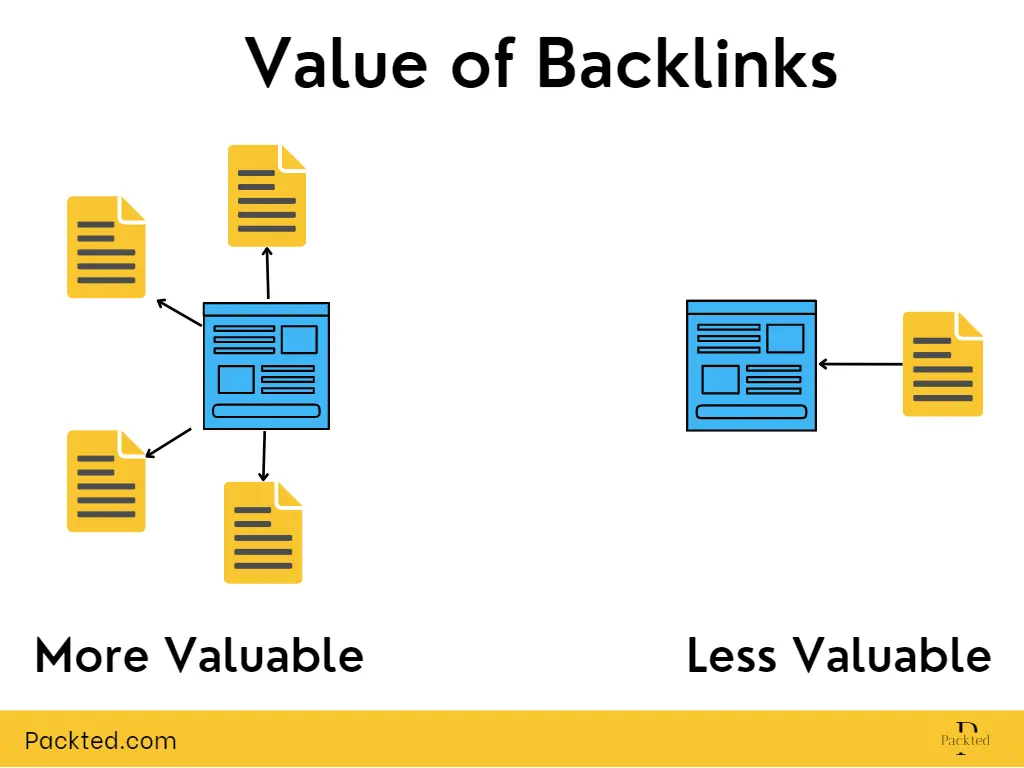Are Backlinks Important for SEO?
Backlinks are probably the number one thing that SEOs care about. They find new ways to build backlinks and increase the authority of the site in the eyes of Google.
But are backlinks as crucial as they used to be? Or is there something else that is not being told?
Toward the end of this post, you will understand everything related to backlinks. Whether or not you should focus on them, and what you should focus on.
Table of Contents
Too Long; Didn’t Read
Backlinks used to be important back then because they help distinguish a good result from others. But as they become more manipulative, they don’t carry the same significance. Backlink will be less important as Google care more about the user experience and a lot of other factors.
What are Backlinks?
A hyperlink that connects two different websites together is called a backlink.
If one website links to another, you can say that it’s a backlink.
For example, if this website (Packted) gives a link to Wikipedia, then it’s a backlink.
Similarly, if Wikipedia links out to Packted, then it’s a backlink.
Here is a visualization of how it looks:

Backlinks are also called External Links, or just links. They are one of the ranking factors that Google uses to rank content in Google searches.
In SEO, backlinks are considered votes.
Just as the political party with the highest votes gets to make the government, a similar concept is applied to backlinks.
The theory is that the page that has the highest number of backlinks gets to rank higher in the results (or SERPs).
Here is a visualization of the same:

This was the basic definition of backlinks. Now, let’s understand…
How Links were Perceived in the Past?
The backlinks used to be a HUGE factor for ranking. Algorithms like PageRank were made explicitly to judge the backlink quality. And as PageRank is an essential factor for ranking, backlinks also become one.
I have found a Stanford paper from 1998 that discusses the importance of PageRank and backlinks. Here are some of the points mentioned:
- Links were also called citations
- “Indeed, many of the web search engines have used backlink count as a way to try to bias their databases in favor of higher quality or more important pages.’’
- “Generally, highly linked pages are more “important” than pages with few links.”
- “Based on the discussion above, we give the following intuitive description of PageRank: a page has a high rank if the sum of the ranks of its backlinks is high. This covers both the case when a page has many backlinks and when a page has a few highly ranked backlinks.”
- “The original goal of PageRank was a way to sort backlinks, so if there were a large number of backlinks for a document, the ‘best’ backlinks could be displayed first.
- “PageRank can help the user decide if a site is trustworthy or not.”
- “The intuition behind PageRank is that it uses information that is external to the web pages themselves – their backlinks, which provide a kind of peer review. Furthermore, backlinks from “important” pages are more significant than backlinks from average pages. This is encompassed in the recursive definition of PageRank.
Similarly, here is an article from Web Confs (2006) discussing the importance of backlinks:
“The number of backlinks is an indication of the popularity or importance of that website. Backlinks are important for SEO because some search engines, especially Google, will give more credit to websites that have a good number of quality backlinks and consider those websites more relevant than others in their results pages for a search query.”
Further, they wrote:
“A search engine considers the content of the sites to determine the QUALITY of a link. When inbound links to your site come from other sites, and those sites have related content, these inbound links are considered more relevant to your site. If inbound links are found on sites with unrelated content, they are considered less relevant. The higher the relevance of inbound links, the greater their quality.”
When we think about the things that have been said above, it becomes clear that backlink was the “hero” back then.
Google gave priority to links and more to “quality” backlinks.
So it is safe to understand why people are obsessed with making links.
The Importance (and Benefits)
Backlinks are important because they can help you get higher rankings in SERPs and can help your website become authoritative.
The first and foremost reason backlinks are essential is that they can help you become more credible and authoritative.
This is because if a more authoritative site mentions your site, then your site will become more credible in the eyes of Google.
For example, if a site like Semrush or Ahrefs mentions Packted on their site, then Google will view Packted as more credible.
This makes more sense when you think of links as votes. If a site has more votes, then it will be more authoritative in its industry (or niche)
The second thing is that Google discovers new pages via links. And this helps Google find new pages. Essentially, backlinks can also help in the URL discovery process.
The next thing to note is that if your site has a backlink from an authoritative site, then it can send you a good amount of traffic. This type of traffic will be called referral traffic, and it can help you attract a new audience and increase your brand awareness.
How many Types does it have?
There are four main types of backlinks: No-follow, do-follow, sponsored, and UGC. Each type serves its own purpose and is used to indicate a different kind of link.
Let’s understand each type of link:
- No-follow: The rel=”nofollow” attribute is used when you don’t want to associate your site with the website you’re linking to. This was mainly introduced to get rid of comment spamming.
- Do-follow: The do-follow link is the one without any attribute. That means, it doesn’t include any nofollow, sponsored, or UGC attributes. This kind of link tells Google that this link is trusted and you can give it credit (or PageRank or some like to say link juice). This is the standard link type, and when everybody aims to build links, this is the type they’re looking for cause it sends authority to your site
- Sponsored: The rel=” sponsored” is used when you’re exchanging money in return for a link (also known as paid links). This can include any promotional activity, and it helps Google to understand the relationship between the two sites.
- UGC: The rel=”ugc” is used to signal Google that the editor of the page does not create a particular link. Sites that are UGC, like social media and forums, have this kind of attribute. You can also enable this attribute if you have enabled comments on your blog.
Recommended Reading: What is the Difference Between Nofollow and Sponsored Links?
How Backlinks are Earned?
Backlinks can be editorial links (placed naturally), manually made, or self-created links.
Let’s understand each in a bit of depth.
- Natural Links: Natural or editorial links are the ones that you earn naturally (just by creating high-quality content). These are the links you get without doing any outreach. People link to your content because they think it is unique and can help the users. For example, suppose someone links to this page because they think this post can help their users, or this is an excellent resource. So that will be a natural link. The content that gets the most natural links is link bait. Essentially, they are either large studies and data-centric posts or a fresh new perspective on regular things.
- Manual Links: These are the links you earn by outreaching different websites. The aim is to get the links within the content, and that’s why they are a little tricky to earn. An example of the manual link is me reaching out to a website to replace their old link with the new article I created. Strategies like broken link building, HARO, link bait, and link reclamation are some examples of manual link building.
- Self-Created Links: As it sounds, the self-created links are created “by oneself”. The catch? Anyone can create these links. They are the lowest-quality links. Examples include links like classifieds, article submissions, social bookmarking, profile creation, and more. Of these three types, these are nofollow links (in most cases), cause they are not special. Anyone can create them.
Whenever you’re building links, I would suggest aiming for natural links. This means you should aim to create content that is unique and link-worthy. Apart from that, you can also go through the manual link path. But don’t invest your time and resources into self-created links. They will do more harm than good on your site.
P.S. I have done a study and found that when a company hires an agency in India, most create self-created links.
Final Thoughts
Even though backlinks are a huge part of the search, they might not have a whole lot of value in the future. As you can see, Google puts user experience above everything else.
To give you proof, here is a video from Google:
To summarise, Google says backlinks are a ranking factor that is way less significant than it was several years ago. Google is also brilliant at detecting unnatural (self-created) links. Their ranking systems are more robust, and they don’t care about backlinks as much.
So instead of focusing on backlinks, maybe we should focus on creating a better user experience for our users.
That’s it for this post. If you want to get in touch, you can contact me.
